If you don’t have time to read the article, then when comparing 24mm vs 35mm lenses, 24mm is the best focal length for travel, interiors and landscapes, while the 35mm focal length is ideal for portraits. You can see examples of this below.
Lenses come in a variety of random focal lengths and apertures. Often the focal lengths are quite close to each other. That makes the decision you have to make a bit more difficult. If you are trying to decide between a 24mm lens or a 35mm lens, this article will be of help.
Using my own experience as a professional photographer, I’ve compared photos taken at both focal lengths so that you can get an idea of which is best for a variety of uses, from portraits to landscape photography.
24mm and 35mm lenses are quite wide lenses on a full-frame camera. The question is, which one is right for you?
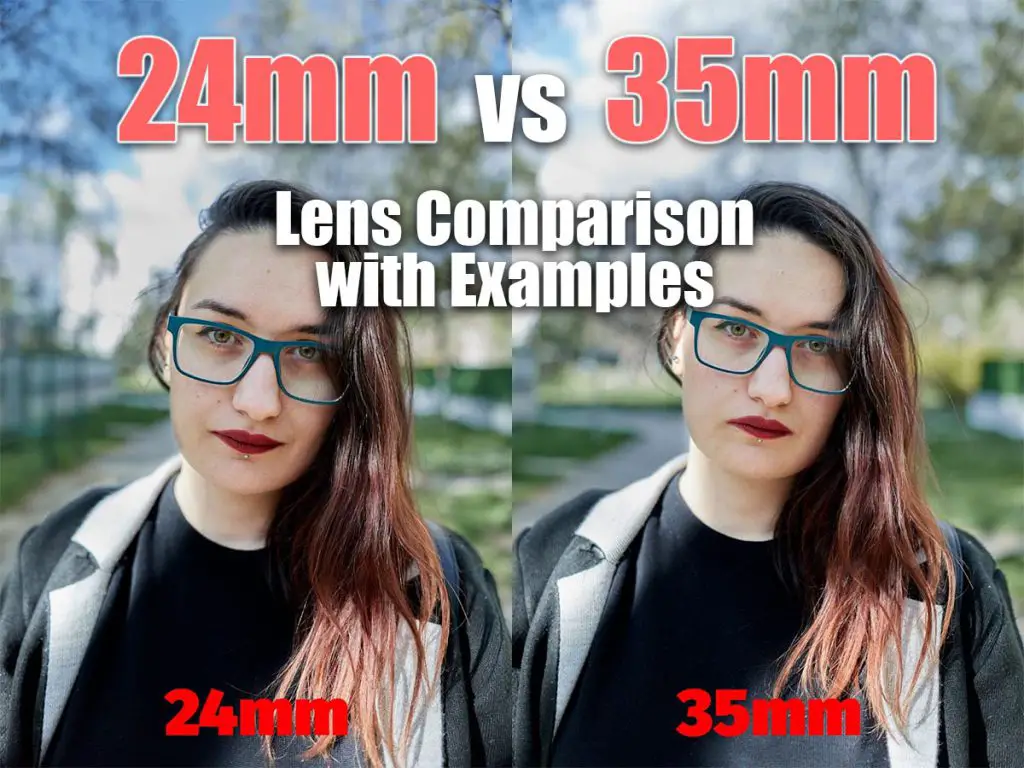
What is a 24mm lens good for?
The 24mm lens is known as the default wide-angle focal length. You will find it on most multi-purpose lenses, like the 24-105mm or the 24-70mm. If you want to fit more in your frame and focus on people less, the 24mm is the right choice.
Low light capabilities
A prime 24mm lens usually comes with a wide aperture, usually f/1.8 or brighter. Being a 24mm lens gives you the ability to shoot slower shutter speeds without motion blur being an issue. The rule of thumb is a shutter speed of 1/50th second (twice the focal length).
Pair that with f/1.8 or a brighter aperture, and you can keep the ISO lower in low-light scenarios. As a result, you will get cleaner photos, or you will be able to have usable photos where you would not have any.
F/1.4 variants of this focal length from the same manufacturer as your camera are quite expensive, costing upwards of $1500. Luckily, Sigma makes an excellent 24mm f/1.4 for around $850.
Portrait work with a 24mm lens
Often you will see photographers avoid the 24mm lens for portraits due to the exaggeration of the facial features. That is true for close-up portraits only. If you go for an American portrait or full body shots, it will work just fine. As the distance from your subject increases, the exaggeration of the facial features decreases.
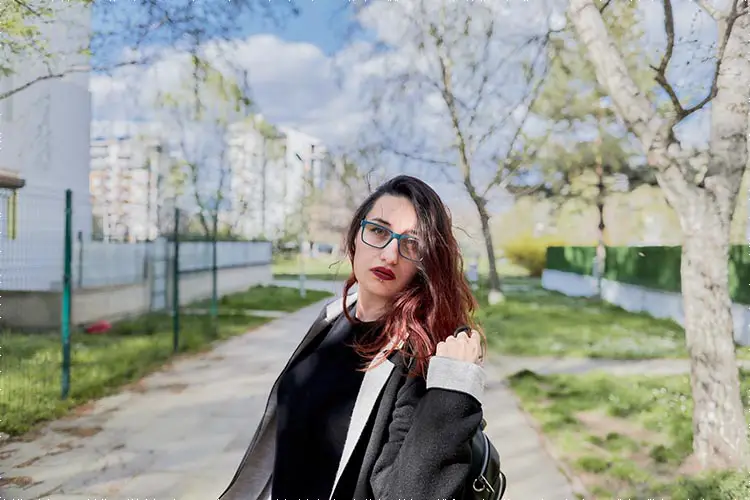
In other words, a 24mm lens is great for environmental portraits. Not exactly a good choice for beauty shots, however.
Interiors and exteriors
The nature of 24mm is the ability to capture more in the frame. That will prove to be quite useful if you are shooting in interiors. It will work great in a cafè or a church. Wide-angle lenses like the 24mm make good use of the lines naturally available, so they do great in cases like this.
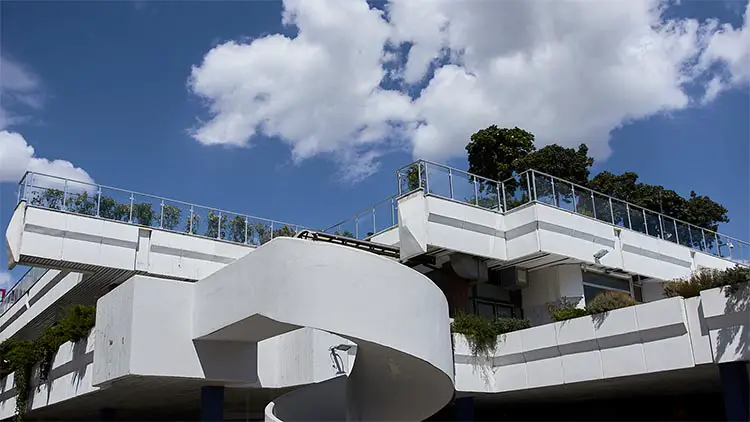
Exteriors, be it cityscapes, landscapes, or architecture, look great at this focal length. Interiors look great as well for the same reason. You can fit more in the frame and make good use of the naturally occurring leading lines.
When should you use a 35mm lens?
You should use a 35mm lens if you are more portrait-oriented and you care more about details than geometry in your photography style.
The 35mm is known as being the widest portrait lens. Of course, this does not mean that you can not shoot a portrait with a 24mm. It just means that with lenses wider than 35mm, there are limitations to what you can do. Otherwise, you risk unflattering photos of your model.
Great for low light scenarios
Like the 24mm lens, the 35mm comes in various maximum apertures. You can easily get your hands on a good 35mm lens with an aperture of at least f/1.8 without breaking the bank. Depending on the brand, an average f/1.8 copy can range from $200 to $800.
However, this will let you shoot at shutter speeds as low as 1/60th without image stabilization. Same as the case with the 24mm lens, you will benefit from cleaner photos and photos that you will not be able to capture otherwise.
F/1.4 versions of the 35mm lens are very expensive, but you can get cheaper alternatives from Sigma or Tamron for about $800-900. But, make no mistake, Sigma makes one of the sharpest lenses on the market.
A great starting point for portraits
As previously mentioned, the 35mm lens is considered the widest portrait lens. Many photographers swear by the 35mm as the perfect portrait lens. In my opinion, that is a bit of a limitation. It works great as a general-purpose portrait lens, as long as you do not expect significant background separation in full-body shots.
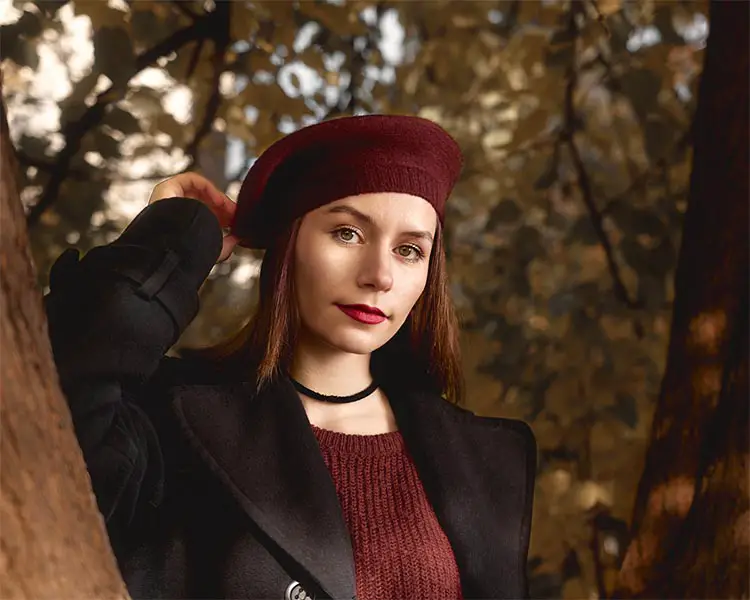
Since it is a 35mm lens, you have a fairly wide focal length, and to fit the model in the frame, you will be nearing the infinity end of the lens. That means that you will not be getting a lot of background blur in that case.
Okay for interior and exterior work
Using a 35mm instead of a 24mm lens for interior work will leave you in a bit of a no man’s land. Meaning that it is just wide enough to pass for work like this, but with limitations. On the other hand, it is just short enough to catch details. It is not here nor there.
It can do the job in a pinch. But, I would not go for a 35mm if I need to shoot an interior or a portrait where the interior is also important. It is not wide enough to emphasize leading lines. They look average. Nor is it long enough to compress the background a bit more to make it useful like that.
It is a matter of preference if you use the 35mm lens for exterior work. It can do most of the things the 24mm can do. You only need to take a few steps back.
24mm vs 35mm for Portraits
Usually, when people think about 24mm lenses, they think about distortion. You can correct most of it, and often it is not an issue, especially for portraits.
Distance exaggeration, however, is an issue. Wider lenses exaggerate distances more, especially with subjects closer to the camera. However, it is imperative to know that distance exaggeration is a matter of perspective. The closer you are to your subject, the more exaggerated the distances are.
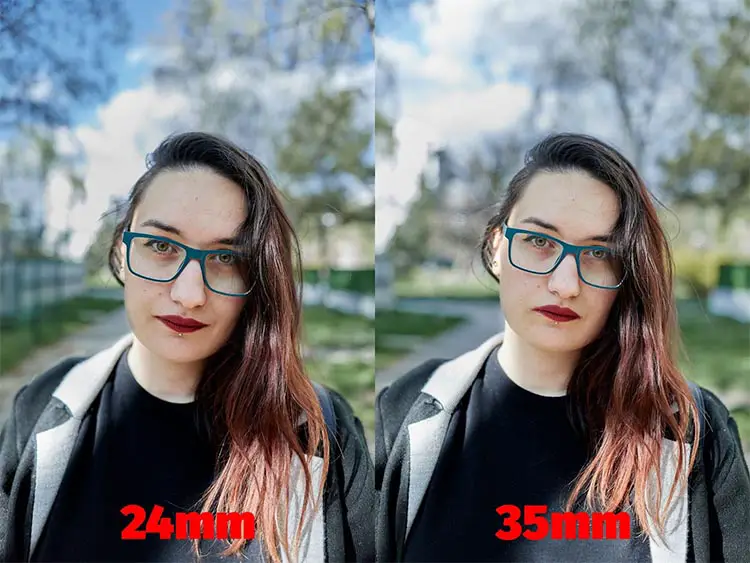
That is why a 24mm lens is not a good choice for close-up portrait work. It makes faces look a bit weird. 35mm lenses suffer from this issue too, but it is not that bad. In this scenario, in my opinion, a 35mm lens is a better choice since it is more flattering.
With a bit more distance to the subject, the difference becomes smaller. There is still some distance exaggeration, and the facial features are not quite as seen with the naked eye, but the differences there are less obvious.
In this case, however, the zoom compression is way more obvious. As you can see on the 35mm lens in the shots below, the background appears closer. Even though both photos were taken at the same aperture, since the 35mm lens compresses the background more (brings it closer), there is more background blur.
Bear in mind to maintain the same framing. I had to move closer to the subject with the 24mm lens.
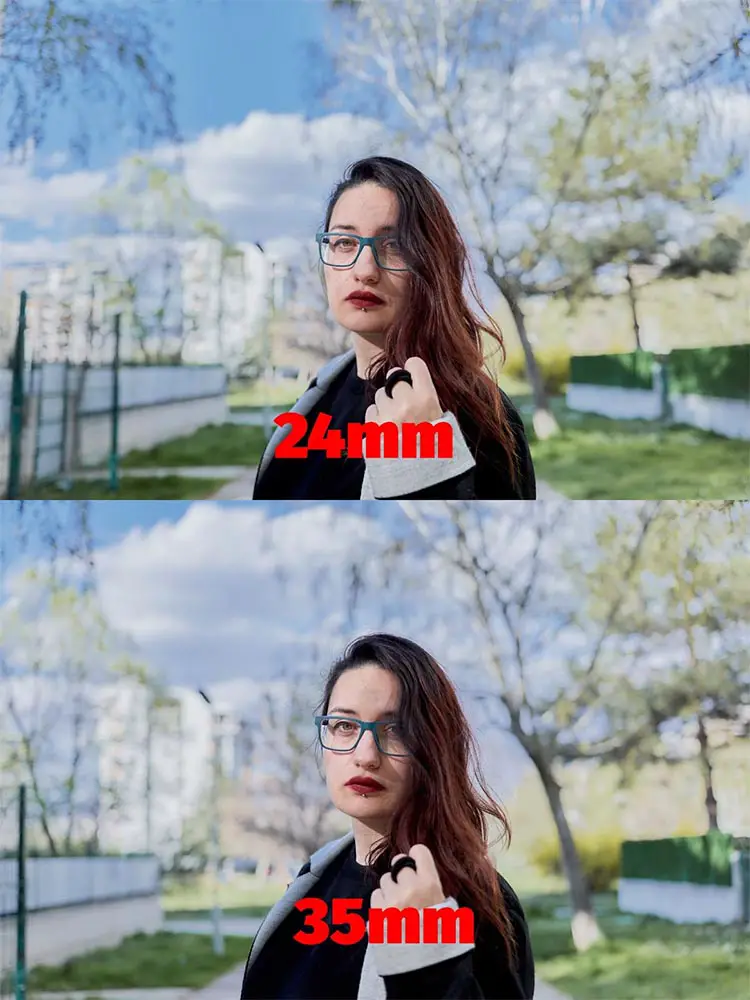
if I keep the same distance to the subject and change the focal length, the difference between 24mm and 35mm is just the background blur and crop. If we were to ignore the background blur for a moment, it looks like the 35mm only crops in the 24mm picture a bit.
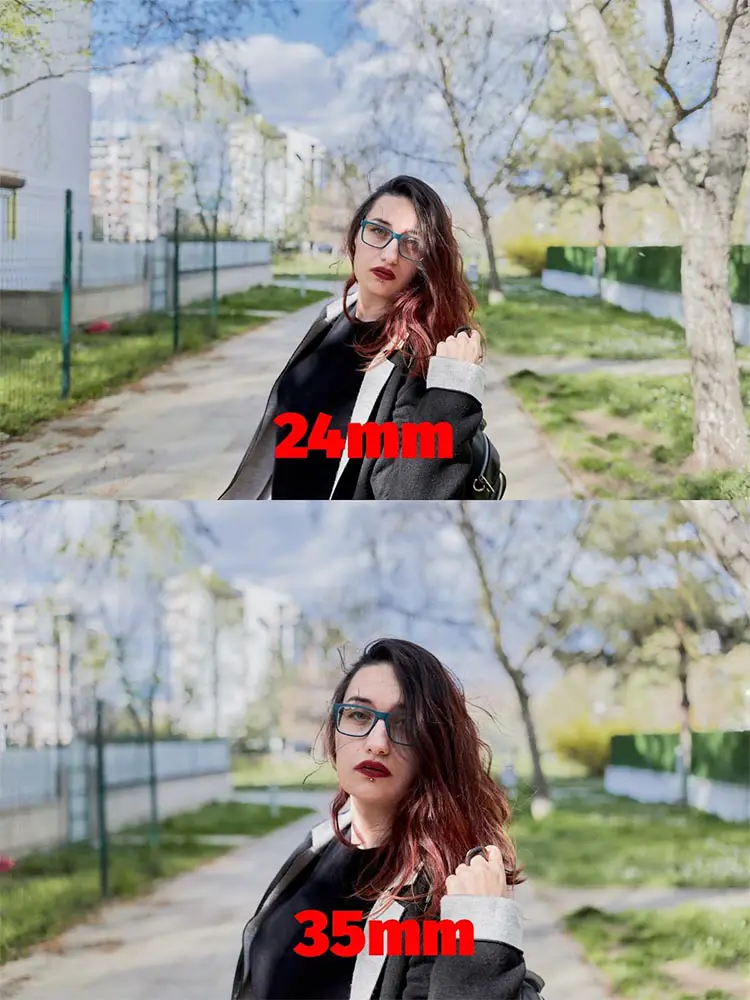
As you can see, the background is not any closer in the 35mm shot if you compare it to the 24mm photo. It just looks cropped in. The facial features do not differ at all. That is because the distance to the subject remains the same between the two shots.
If I were to crop the 24mm image to match the 35mm image, you would see very little difference, if there is any. The only difference is the background blur. I’ve shot both photos with the same aperture at the same settings and the same distance to the subject. The 35mm shot has a slightly blurrier background.
If you are cropping in the 24mm lens slightly, you will be losing some background blur. In the case of the photos below, the 35mm and the 24mm photos are both shot at f/2. The 24mm shot then got cropped roughly 1.45x to match the 35mm shot. That means the background blur on the cropped 24mm photo is equal to a photo taken at 35mm and approximately f/2.8, because aperture is a function of focal length.
In any case, at this distance, f/2 and f/2.8 look kind of similar. Bear in mind, however, that the background blur changes, but not the brightness of the image.
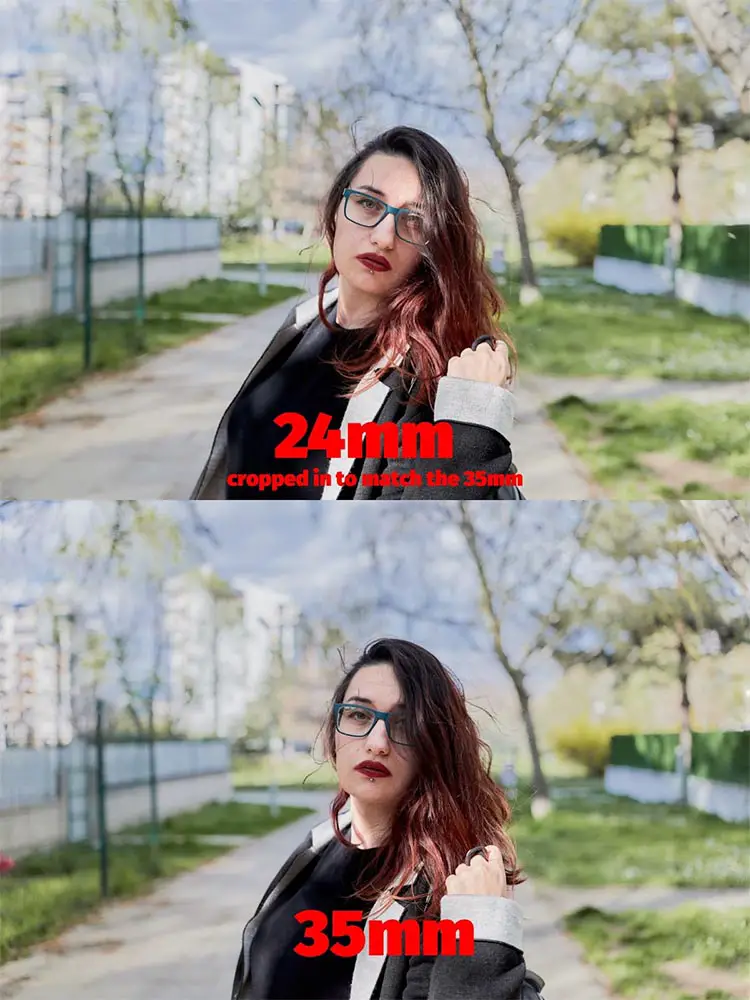
At the end of the day, if you are going to shoot portraits, the 35mm lens is more versatile. You can do close-up portraits without too much feature exaggeration, and you can do full-body environmental portraits if you only take a few steps back. The 24mm lens will not be able to do close-ups unless you crop in significantly. That sacrifices resolution and sharpness.
Read More:
24mm vs 35mm for Travel
Choosing between two lenses for travel largely depends on your shooting style. Personally, I tend to shoot architecture and landscapes more when traveling. You might be more interested in shooting people, like your family or significant other. It is a matter of preference and style.
If you shoot people more than locations, then the portrait section of this article applies here.
However, if you are interested in locations more than people, that changes things a bit.
When shooting exteriors, the 24mm lens has a 1.45x wider field of view, meaning that you can capture more in one frame. You can always crop in the 24mm if you need something closer.
Even though you are sacrificing some resolution, at least you will have a shot of what you intended to photograph. With a 35mm in this situation, you will have to rely on shooting a panorama and hoping that you took it right and that it will stitch correctly.
As you see below, the difference is significant.
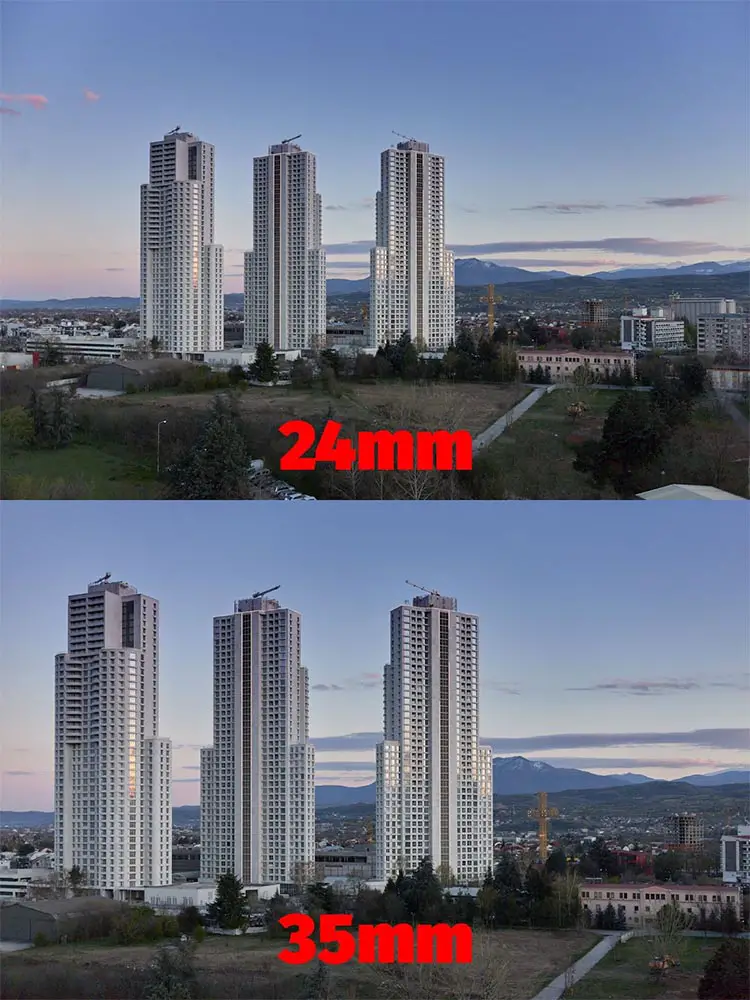
On the other hand, if you shoot interiors, a café, for example, a 35mm lens can be too long. While photographing the demo shots for this article, I could barely squeeze in a photo with the 24mm lens without bothering the people at the nearest table.
In this case, you can notice the difference in background compression, as is the case with the portraits. But, I do not think it matters too much for this type of photography.
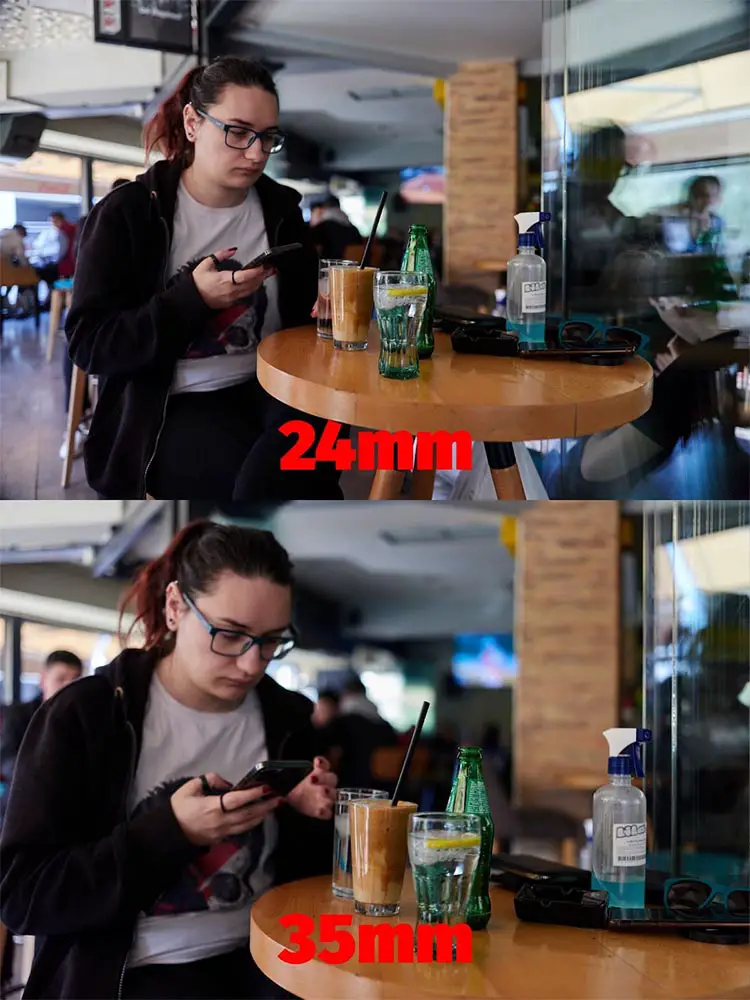
If we have to weigh the pros and cons between these lenses for travel, I would say that a 24mm lens is the more logical choice. It provides fewer limiting factors than the 35mm, and with a bit of sacrifice in resolution and bokeh, it can do what the 35mm does.
Of course, personally, I would bring a telephoto lens with me for travel too, because I like to hunt for distant details. But that is just me.
35mm vs 24mm Overall Comparison
There is no clear winner here, but really there cannot be one. The 35mm vs 24mm focal lengths are exceptionally close to each other, meaning that the choice falls on you and your photography style.
Once you understand what each lens does at what distance and what compromises you can make with each one, the choice is quite easy.
The simple summary is that if you orient yourself more towards portraits a 35mm lens is the way to go. On another hand, if you orient yourself more towards landscapes, cityscapes, and architecture, a 24mm lens is the better choice.
Read More:
35mm vs 28mm focal length comparison
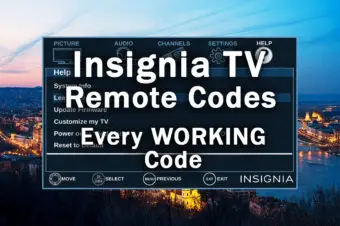


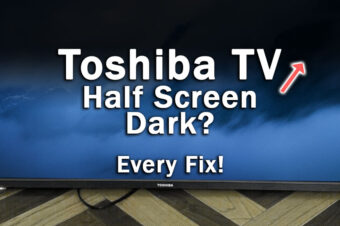
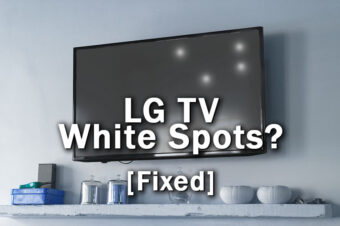

Leave a Reply